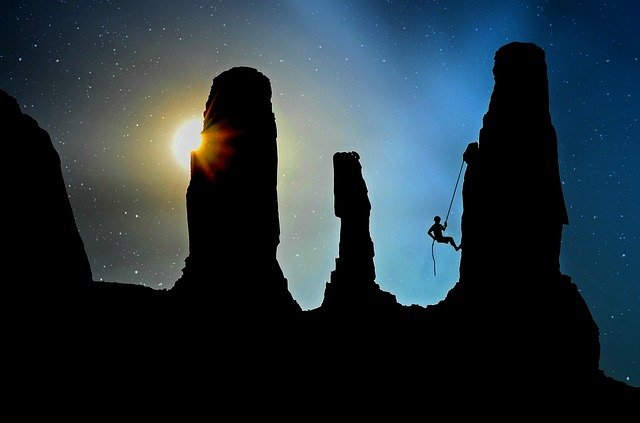Do you consider that you are the type of people who are adventurous, who like to live new experiences and who set themselves ever greater challenges? Do you like living on the edge of the abyss? Do you enjoy the tickle in the stomach that produces a strong adrenaline rush?

If you answered yes to at least a couple of these questions, you are probably someone who enjoys extreme sports. In your case, it is all or nothing, because there are no intermediate points or a comfort zone where you can stay.
You constantly need to get out of the boredom of everyday life to drain all the accumulated tension and to release the stress generated by city life. For this reason, you resort to places where you can be in contact with nature and thus rediscover yourself with nature and with yourself.
Actually, within extreme sports there is a lot to choose from. There are those that have to do with heights, with speed, with maximum physical resistance, among others. However, how many of them manage to combine adrenaline with the tranquility of nature? It may seem to you that there is no such activity. However, you couldn’t be further from the truth.
Have you ever heard of mountaineering ? What do you associate this word with? Yes, with the mountains. But, what is it about? As practiced? What risks do you run? What do you need to practice it? Is it a group or solo activity? Do you have to be an expert?
If you would like to do mountaineering, you need to answer each and every one of these questions, since it is an unconventional activity that you do not have much knowledge about. However, in this article, you will be able to be aware of these and other aspects related to this activity to practice it whenever you want. Without further ado, let’s get down to business right now.
Instructions
It is a sport that consists of walking and hiking in the mountains, going up and down them. His main motivation is destiny, the mountains and their routes are more difficult.
Depending on the goal of the mountaineer, if he wants to reach the top of the mountain, it can be defined as Ascension. However, if it requires any climbing technique then it is known as Alpinism.
In addition, we can say that it is not a simple sport, it is also a recreational activity that is related to the exploration of the environment, as well as the love for nature.
On the other hand, it should be noted that it is one of the sports that has the greatest history and tradition in the life of man. It originated in the Alps at the end of the 18th century, hence it is also known by the name of Alpinism.
Among the most famous mountaineers are the first two people to reach the top of Mount Everest, which is more than 8,000 meters high.
Her CARACTERISTICS
To practice this sport, a series of skills is required, some of them are: rock climbing, rappelling, etc. Unlike hiking, the difficulty, the duration of the climbs and the presence of dangerous conditions are greater.
It can also mean spending a night, or even more, in the mountains, which requires the use of a lot of equipment and is usually practiced in a group or at least in pairs.
Depending on the type of terrain, the height of the mountain and the weather conditions, mountaineering excursions can be classified as low, medium and high mountains. However, this classification varies depending on where in the world we are.
As for the low mountains, in Spain it reaches up to 1500 meters. It is an area where vegetation abounds and there are few rocks. Hiking is often practiced in this type of terrain.
In relation to the average mountain, the height in Spain ranges from 1,500 meters to 2,500. It consists of a landscape full of robust trees and rocks. In the winter season there is usually snow. Due to these characteristics, the practice of hiking and trekking is common.
Finally, the high mountain ranges from 2,500 meters onwards. Its terrain is usually rocky and with no vegetation. Its temperatures are extreme and it is ideal for mountaineering.
On the other hand, within mountaineering we can find different disciplines, depending on their difficulty, their objective and the materials used, some of them are the following:
- Hiking: they are nothing more than walks made through the low and medium mountains, whose difficulty is of lesser intensity. In general, the excursions do not usually last more than one day and are carried out along paths and trails that are signposted. Therefore, it is also known by the name of hiking.
- Mountaineering: is the mountaineering that is done in the high mountains. Your goal is to reach mountains by overcoming some difficulties such as rocks, snow and ice. Therefore, the use of specific materials is required, such as crampons, harness, helmet, ropes, etc.
- Ascensions: this type of mountaineering is carried out in medium and high mountains and its objective is to reach the top, which is why it may require climbing in some sections. It does not usually merit the use of technical material. However, depending on the conditions of the terrain and the time in which you want to make the ascent, it may be necessary to use technical materials, such as rope, snowshoes, crampons, etc.
- Climbing: it consists of making climbs or ascents on very steep walls. Therefore, it requires the support of hands and feet to be able to climb with the use of materials, such as the harness, ropes, helmet, etc.
- Mountain skiing: it is a type of mountaineering, in this case a winter one, which is done with skis.
What do you need
When practicing mountaineering you must have:
- Water and food, which must go inside a backpack.
- A helmet to be protected against landslides of sand and rocks.
- the appropriate strings.
- The pitons to stick into the rocks and thus anchor the ropes or screws, in case the mountain is full of ice.
- A harness to hold the ropes.
- Depending on the terrain, special shoes or climbing boots may be needed.
- Different devices that are connected to the ropes and that allow different types of movements to be carried out, such as carabineers or rappelling devices.
- Gloves, which must be elastic and synthetic fiber.
- Sunglasses and blizzards. These are very important to avoid photothalmia and other eye problems that are caused by the incidence of ultraviolet and infrared rays in the eyes.
Given that it seems to be a sport that carries certain risks, have you ever wondered what the advantages of practicing it are? Let’s see it right now.
Tips
- Mountain walks strengthen the muscles of the buttocks and legs, much more than practicing other types of exercise.
- On the uphill’s you get resistance and toning of the muscles, while on the downhills, their elasticity increases.
- It provides psychological benefits, since contact with nature generates a feeling of tranquility and peace of mind.
- It prevents heart disease, as well as arthritis and lower back pain, as it activates circulation.
However, as expected, not everything is rosy. This sport also carries a number of disadvantages. But what are they?
Your Disadvantages
- Weather: Sudden changes in the weather can transform a perfect day of climbing into a nightmare in a couple of minutes, a situation that could be life-threatening. Therefore, it is best to start the climb very early, before dawn, to be able to finish it by noon.
- Equipment: When equipment is in poor condition, it can result in serious injury or even death in the event of a fall. For traditional climbs, knowledge of how to set up equipment safely is necessary.
- As for your clothing, it must be necessary to wrap up and unwrap quickly. Clothing should be warm and solid, but also comfortable. They must be garments that facilitate blood circulation and appropriate footwear. Otherwise, a lot of mishaps could arise during the excursion.
- Fauna: you must know how to deal with insect bites. In addition, there is the possibility of having contact with poisonous plants and snakes, which can lurk in the shadows of the cracks and crevices, which are used as supports to climb the rock walls.
- Likewise, it must be clear that there is the possibility of stone falls, landslides, avalanches, snow, glacial cracks, cold blizzards, etc.
Main causes of risk
In addition to this, there are general causes that can lead to different types of accidents. Some of them are:
- The ignorance.
- The inexperience.
- Not having enough knowledge about mountaineering.
- Have faulty or incomplete equipment.
- Being in poor physical condition.
- Overconfidence by experienced staff, etc.
Regardless of whether it is a professional or an amateur, anyone who decides to carry out activities in the mountains must keep in mind that it is not free of dangers. In addition, despite all the training he may have, he is always in constant learning, since hypothetical situations are sometimes far from the real ones.
Therefore, if you decide to practice mountaineering, it is best to seek help from professionals in the field, that you have the necessary equipment and that you take into account all the preventive measures to have a perfect day of hiking.




